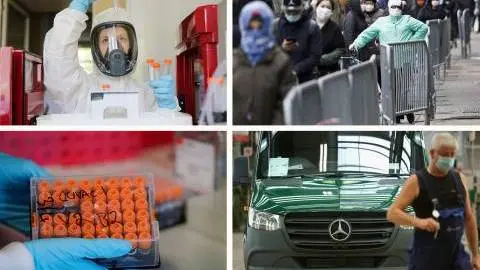US: The surge subsides
High-frequency data suggests that the post-reopening surge in activity began to moderate in July and this process continued throughout August. With the pandemic continuing to create many challenges, we doubt the economy will fully heal before 2022
Signs of plateauing
The US economy has rebounded vigorously in the wake of the reopenings that started in May and we have revised up our growth forecast for 3Q20 in response to the stronger tone from the data. Consumer spending is nearly back to where it was pre-pandemic and manufacturing output is bouncing strongly. Meanwhile, equity markets are at new all-time highs on optimism that the US is firmly on the road to recovery.
However, we continue to believe that equity markets are pricing in too positive an assessment over the medium term.
Firstly, consumer confidence has fallen back to cycle lows on the back of health anxieties in response to a recent acceleration in Covid-19 cases. In turn, this has prompted back-tracking from several states, resulting in the reintroduction of containment measures that have had a detrimental impact on many businesses and employment prospects.
Then there is the impact of the reduction in the additional Federal unemployment benefit payment from $600 to a notional $400 per week.
Homebase employment data & TSA security airport check numbers
Political and structural risks set to weigh
High-frequency labour market indicators already suggest a plateauing in job creation and the same can be said for credit and debit card transaction numbers. Likewise, there has been a levelling off in passenger flights and hotel bookings. It looks as though the recovery is losing some momentum with 4Q GDP growth likely to be substantially lower than the 26% annualised figure we expect for 3Q.
Given the short, medium and long term issues, we continue to think it will be mid-2022 before all of the 1H20 lost output is fully recovered
A divisive presidential election campaign could take further steam out of the recovery especially if protests and violence spread to more US cities.
Concern over whether the postal system can cope with a surge of mail-in voting is also a major issue. It could mean that it could be days or even weeks (if there are legal challenges) before we know who has won, which would add an extra layer of uncertainty that could be economically disruptive.
Uncertainties over the timing and efficacy of a vaccine coupled with the threat of a renewed spike in Covid-19 cases in the latter part of the year mean the strains facing the travel, hospitality and entertainment industries will continue. Given these sectors are relatively large in the US this adds to our wariness on getting too excited about the speed of recovery. Then there are the structural effects of a more permanent work from home attitude from workers and what this means for metropolitan centres when there is less consumer footfall.
Given these short, medium and long term issues, we continue to think it will be mid-2022 before all of the 1H20 lost output is fully recovered.
Download
Download article
3 September 2020
Covid-19: The virus, the vaccine and what next for the global economy? This bundle contains 10 ArticlesThis publication has been prepared by ING solely for information purposes irrespective of a particular user's means, financial situation or investment objectives. The information does not constitute investment recommendation, and nor is it investment, legal or tax advice or an offer or solicitation to purchase or sell any financial instrument. Read more
